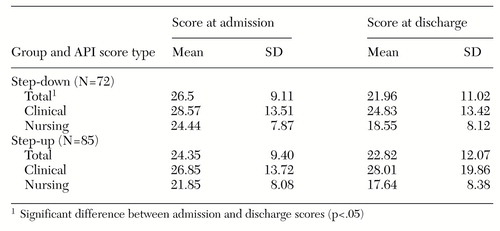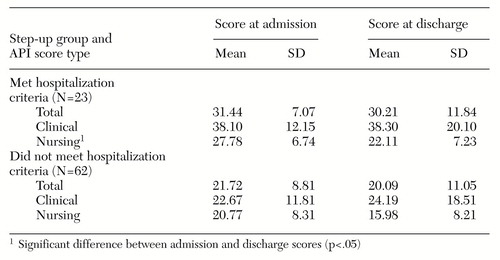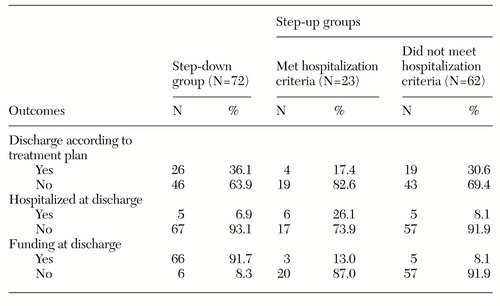An Emergency Housing Program as an Alternative to Inpatient Treatment for Persons With Severe Mental Illness
Abstract
OBJECTIVE: This study evaluated the feasibility and effectiveness of an emergency housing program as a step-down program after inpatient care, as a step-up program from community-based living, and as an alternative to inpatient care for individuals with serious mental illness who sought treatment at an urban medical center. METHODS: One hundred sixty-one persons admitted consecutively to an emergency housing program were assessed retrospectively with the Severity of Psychiatric Illness scale and the Acuity of Psychiatric Illness scale at admission and again at discharge. Analyses of covariance were used to evaluate the change in residents' clinical acuity and psychosocial status between admission and discharge. RESULTS: Residents who had been admitted to the emergency housing program from inpatient psychiatric treatment showed a significant decline in acuteness of psychiatric symptoms. Psychiatric symptoms also improved for residents who were admitted to the program from community-based service programs and for residents admitted as an alternative to inpatient treatment, although the differences for these two groups were less prominent. CONCLUSIONS: The findings suggest that an emergency housing program is a feasible mode of extended community-based care for many persons with serious and persistent mental illness.
Deinstitutionalization was intended to improve the lives of persons with serious and persistent mental illness by replacing institutional care with community-based services (1). However, evidence suggests that failure of the system to provide even the most basic services—for example, housing—has contributed to higher rates of homelessness and frequent hospitalization among this population (2,3,4,5). Although the extent to which psychiatric symptoms, psychosocial stressors, and poverty contribute to these problems is unknown, it is clear that the need for comprehensive, community-based services that make community living possible is not met (5,6,7).
Over the past several decades, residential crisis facilities have developed as a potentially less costly and less restrictive alternative to psychiatric hospitalization (8,9,10,11,12), and a wide variety of treatment programs have evolved within this approach (13,14,15,16). One example is the emergency housing program, which is designed to provide temporary housing, case management, 24-hour supervision, and linkage to community-based psychiatric services to persons experiencing acute episodes of psychiatric symptoms.
As a step-up program from community-based living, emergency housing can provide residents with more structure and safety during times of crisis. As a step-down program from inpatient treatment, it can facilitate the transition from inpatient to independent community-based living by providing time to address the complex needs of persons with severe mental illness before their release.
The need for programs of this sort has grown in recent years, partly as a result of the decreasing length of inpatient stays and reduced availability of inpatient beds, particularly in state-operated facilities (16). Several studies indicate that temporary supportive housing facilities can serve as an alternative to inpatient treatment (8,9,10,11,12,13), but there is disagreement over whether less restrictive alternatives to hospitalization can adequately provide the care and structure offered by an inpatient unit (17,18). Still, inpatient care is not accessible within the current health care system for all who seek it or could benefit from it (16); therefore, efficient alternatives are needed.
The goals of the study reported here were to evaluate the effectiveness of emergency housing programs and to determine their utility and feasibility as an alternative to inpatient treatment for persons with serious and persistent mental illness.
Methods
Subjects
Data were obtained in July 1995 through a retrospective chart review of all 161 persons admitted consecutively to the emergency housing program at Northwestern Memorial Hospital in Chicago between November 1993 and October 1994. For persons with multiple admissions during this period, only the first admission was included. The emergency housing program is a transitional supportive housing program. It has 25 beds and houses men and women age 18 to 75 for one to three months.
Measures
Three measures were used to collect and assess data: the program's own service evaluation study questionnaire, the Severity of Psychiatric Illness (SPI) scale, and the Acuity of Psychiatric Illness (API) scale (19).
The service evaluation questionnaire was used to obtain the residents' demographic characteristics, along with housing and funding status and linkage to psychiatric treatment at admission to and discharge from the program. Information about funding status was also obtained by reviewing medical charts, which included hospital records on billing documentation and public assistance records.
The SPI scale was developed to help predict utilization of services in acute care facilities. It can be used either prospectively or retrospectively with comparable reliability and validity (19,20,21,22,23,24,25,26,27,28). In this study, it was used retrospectively through medical chart review. Three SPI indexes—suicide potential, danger to others, and severity of psychiatric symptoms—used together have been shown to be a valid predictor of the decision to hospitalize by emergency room personnel (20). A patient's scores for the three indexes are used in a formula to compute an overall probability of admission score (23).
The API scale is used to evaluate the levels of clinical change (clinical status) and service need (nursing status) during the use of acute psychiatric services (28). The API scale has been shown to be a reliable and valid outcome measure in crisis settings in both prospective and retrospective applications (19,20,22,23,24,25,26,28). As was the SPI scale, it was used retrospectively in this study.
Procedure
The chart reviewers were graduate students who had participated in training sessions for the API and SPI scales. To establish interrater reliability, each reviewer rated the same five charts, and 25 percent of all charts were reviewed by one of the reviewers as well as an independent reviewer. Kappa reliability was .86 for the SPI and the API across all of the raters.
On admission to and discharge from the emergency housing program, residents were evaluated using all three measures. For the analyses described below, residents were assigned to one of three groups. Residents who had been admitted to the program directly from an inpatient unit were designated as the step-down group. Residents who had been referred by a community service provider were divided into two groups, designated as step-up groups, according to whether their SPI scores indicated that they did or did not meet criteria for hospital admission.
Data analyses
Analyses of covariance were used to evaluate the change in API scores between admission and discharge within and across the three groups. For the first set of analyses, the independent variable was step-up status. Covariates were the clinical API, nursing API, and total API scores on admission to the emergency housing program; the dependent variables were the same scores at discharge.
The second set of analyses included only residents in the two step-up groups; the independent variable was whether or not the residents met hospitalization criteria. Again, the covariates were the three API scores at admission, and the dependent variables were the scores at discharge. Finally, the same method was used to compare dispositional and supportive outcomes between the three groups. The two dispositional outcomes were defined as hospitalization at discharge and whether discharge from the emergency housing program was or was not according to treatment plan; the supportive outcome was funding at discharge.
Results
Sociodemographic characteristics
The mean±SD age of the 161 residents was 37.5±11.2 years. Most of the residents were male (103, or 64 percent). Ninety-one were Caucasian (57 percent), 63 were African American (39 percent), and five were Hispanic (3 percent). The majority of residents had never been married (111, or 69 percent), 41 were divorced or separated (25 percent), four were married (3 percent), and two were widowed (1 percent). No significant demographic differences were found between the three groups.
Clinical and psychosocial outcomes
Residents in the step-down group showed significant improvement in clinical outcomes at discharge, as indicated by their API scores (Table 1). Residents in both step-up groups also improved on API scores between admission and discharge (Table 2), although the changes were not statistically significant. All residents showed improvement between admission and discharge in scores on need for hospitalization and—with the exception of step-down residents—for funding at discharge, although these changes were not statistically significant (Table 3).
Discussion and conclusions
The findings presented here suggest that emergency housing programs can serve as an effective form of alternative residential care for many people with serious and persistent mental illness. The clinical outcomes for the residents in all three groups in our study were relatively comparable to the outcomes of similar studies that assessed the effectiveness of residential alternatives to inpatient care (11,12).
Our results suggest that emergency housing is somewhat more effective as a step-down program from inpatient treatment than as a step-up program from community-based living. It may be that a short inpatient stay before entry into an emergency housing program facilitates more significant clinical benefits, affording step-down residents a head start in the recovery process. Certain unique features of inpatient treatment, such as the high level of security or intensive medication management, may contribute to more rapid clinical improvement, even after discharge.
Further investigation into the aspects of inpatient treatment that are most strongly associated with clinical improvement may be useful in identifying features that are unique and clinically efficacious and distinguishing them from those that can be delivered in an alternative setting such as emergency housing. Also, efforts to more specifically identify and address the needs of residents who are referred to more intensive programs may improve program effectiveness.
Although the residents who were referred from community-based living and met criteria for hospital admission did not show statistically significant improvement on outcome measures, the direction of change in scores was positive. It did not appear to matter whether a person admitted directly from the community met the clinical criteria for psychiatric hospitalization. These results suggest that about 75 percent of persons in this study who avoided hospital admission by entering the emergency housing program (as shown in Table 3) were able to use the program as an effective alternative to hospitalization.
Interestingly, residents who met criteria for hospital admission exhibited a significant improvement in nursing scores, which may indicate a need for care that is not strictly clinical. Supportive care provided as a nontreatment aspect of inpatient treatment, such as housing, food, and security, may be an integral part of the recovery process during stages of acute illness. Fulfillment of many of these needs in a longer-term, less-structured environment such as an emergency housing program may be feasible and helpful in initiating a therapeutic process when inpatient care is limited or unavailable.
Our study had several shortcomings. First, raters were not blinded to the step-up or step-down status of the residents. Second, we lack information about the residents' psychiatric status and psychosocial functioning after discharge from the emergency housing program. Long-term follow-up data could help illustrate whether emergency housing programs effectively facilitate a stable transition into long-term community living and whether clinical improvements are enduring or transient. Finally, the generalizability of our findings to other crisis residential programs may be limited because of programmatic differences.
Future studies to compare the course of illness and community tenure among persons who receive only inpatient treatment and those treated only in emergency housing programs would help determine the relative efficiency as well as the effectiveness of this alternative to inpatient care. In addition, investigations focusing on overall costs of mental health expenditures in service systems that use an emergency housing program in conjunction with, and as an alternative to, inpatient treatment would facilitate a direct evaluation of cost-effectiveness. Because history of inpatient treatment is a strong predictor of hospitalization (29), use of alternative forms of care such as emergency housing programs to avoid hospitalization altogether might be an important avenue to explore.
Dr. Goodwin is a postdoctoral research fellow in psychiatric epidemiology with the division of epidemiology at Joseph L. Mailman School of Public Health and the department of psychiatry of the College of Physicians and Surgeons at Columbia University, 600 West 168th Street, New York, New York 10032 (e-mail, [email protected]). Dr. Lyons is associate professor of psychiatry, medicine, and preventive medicine and director of the mental health services and policy program of the Institute for Health Services Research and Policy Studies of Northwestern University in Chicago.
 |
Table 1. Acuity of Psychiatric Illness (API) scores of residents admitted from inpatient hospitalization (step-down group) and residents admitted from community-based living (step-up groups) at admission to and discharge from an emergency housing program
 |
Table 2. Acuity of Psychiatric Illness (API) scores at admission and discharge of residents in an emergency housing program admitted from community-based living (step-up groups) who did and did not meet criteria for hospitalization
 |
Table 3. Outcomes of residents in an emergency housing program admitted from inpatient hospitalization (step-down group) or from community-based living (step-up groups) who did and did not meet criteria for hospitalization
1. Ogilvie RJ: The state of supported housing for mental health consumers: a literature review. Psychiatric Rehabilitation Journal 21:122-131, 1997Crossref, Google Scholar
2. Rosenfield S: Homelessness and rehospitalization: the importance of housing for the chronic mentally ill. Journal of Community Psychology 19:60-70, 1989Crossref, Google Scholar
3. Mechanic D: Evolution of mental health services and areas for change. New Directions for Mental Health Services, no 36:3-13, 1987Google Scholar
4. Drake RE, Wallach MA, Hoffman JS: Housing instability and homelessness among aftercare patients of an urban state hospital. Hospital and Community Psychiatry 40:46-51, 1989Abstract, Google Scholar
5. Bachrach LL: The homeless mentally ill, in The Chronic Mental Patients II. Edited by Menninger WW, Hannah G. Washington, DC, American Psychiatric Press, 1987Google Scholar
6. Hopper K, Hamburg J: The making of America's homeless: from skid row to new poor, 1945-1984, in Critical Perspectives on Housing. Edited by Bratt RG, Hartman C, Meyerson A. Philadelphia, Temple University Press, 1986Google Scholar
7. Bassuk EL, Lamb HR: Homelessness and the implementation of deinstitutionalization. New Directions for Mental Health Services, no 30:7-14, 1986Google Scholar
8. Stroul B: Residential crisis services: a review. Hospital and Community Psychiatry 39:1095-1099, 1988Abstract, Google Scholar
9. Mosher LR, Menn A, Matthews SM: Soteria: evaluation of a home-based treatment for schizophrenia. American Journal of Orthopsychiatry 45:455-467, 1975Crossref, Medline, Google Scholar
10. Simpson CJ, Hyde CE, Faragher EBB: The chronically mentally ill in community facilities: a study of quality of life. British Journal of Psychiatry 154:77-82, 1989Crossref, Medline, Google Scholar
11. Sledge WH, Tebes J, Rakfeldt J, et al: Day hospital/crisis respite care versus inpatient care: I. clinical outcomes. American Journal of Psychiatry 153:1065-1073, 1996Link, Google Scholar
12. Brook, BD: Crisis hostel: an alternative to psychiatric hospitalization for emergency patients. Hospital and Community Psychiatry 24:621-624, 1973Medline, Google Scholar
13. Turner J, Wan, T: Recidivism and mental illness: the role of communities. Community Mental Health Journal 29:3-13, 1993Crossref, Medline, Google Scholar
14. Fishel L: A preliminary study of recidivism under managed mental health care. Hospital and Community Psychiatry 44:919-920, 1993Abstract, Google Scholar
15. Dincin J, Wasmer D, Witheridge TF, et al: Impact of assertive community treatment on the use of state hospital inpatient bed-days. Hospital and Community Psychiatry 44:833-838, 1993Abstract, Google Scholar
16. Minkoff K, Pollack D (eds): Managed Mental Health Care in the Public Sector: A Survival Manual. Chronic Mental Illness, vol 4. Singapore, Harwood Academic, 1997Google Scholar
17. Lieberman PA, Witala SA, Elliott B, et al: Decreasing length of stay: are there effects on outcomes of psychiatric hospitalization? American Journal of Psychiatry 155:905-909, 1998Google Scholar
18. Geller JL: "Anyplace but the state hospital": examining assumptions about the benefits of admission diversion. Hospital and Community Psychiatry 42:145-152, 1991Abstract, Google Scholar
19. Lyons JS: The Severity and Acuity of Psychiatric Illness-Adult Version. San Antonio, Psychological Corp, 1998Google Scholar
20. Lyons JS, Stutesman J, Neme J, et al: Predicting psychiatric emergency admissions and hospital outcomes. Medical Care 35:792-800, 1997Crossref, Medline, Google Scholar
21. Anderson RL, Lewis D: Clinical characteristics and service use for persons with mental illness living in an intermediate care facility. Psychiatric Services 50:1341-1345, 1999Link, Google Scholar
22. Yohanna D, Christopher NJ, Lyons JS, et al: Characteristics of short-stay admissions to a psychiatric inpatient service. Behavioral Health Service and Research 25:337-346, 1998Crossref, Medline, Google Scholar
23. Leon SC, Lyons JS, Christopher NJ, et al: Psychiatric hospital outcomes of dual diagnosis patients under managed care. American Journal of Addictions 7:81-86, 1998Crossref, Medline, Google Scholar
24. Lyons JS, O'Mahoney MT, Miller SI, et al: Predicting readmission to the psychiatric hospital in a managed care environment: implications for quality indicators. American Journal of Psychiatry 154:337-340, 1997Link, Google Scholar
25. Lansing AE, Lyons JS, Martens LC, et al: The treatment of dangerous patients in managed care: psychiatric hospitalization utilization and outcome. General Hospital Psychiatry 19:112-118, 1997Crossref, Medline, Google Scholar
26. Lyons JS, Thompson BJ, Finkel SI, et al: Psychiatric partial hospitalization for older adults: a retrospective study of case-mix and outcome. Continuum 3:125-132, 1996Google Scholar
27. Lyons JS, O'Mahoney M, Doheny K, et al: The prediction of short-stay psychiatric inpatients. Administration and Policy in Mental Health 23:17-25, 1995Crossref, Google Scholar
28. Lyons JS, Colletta J, Devens M, et al: The validity of the Severity of Psychiatric Illness in a sample of inpatients on a psychogeriatric unit. International Psychogeriatrics 7:407-416, 1995Crossref, Medline, Google Scholar
29. Anthony WA, Cohen MR, Vitalo R: The measurement of rehabilitative outcome. Schizophrenia Bulletin 4:365-383, 1978Crossref, Google Scholar



